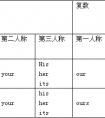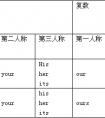用所给词的适当形式填空。 1.Excuse ______ (I) , is this your eraser?2. Lucy and Lily have two new ______ (watch).3.Look! A set of keys ______ (be) under the -七年级英语
④以重读闭音节结尾的动词,并且末尾只有一个辅音字母,应双写这一字母,再加ing,如cut→cutting、swim→swimming
注:结尾是x则不必双写,如relax→relaxing
⑤以ie结尾的动词,要把ie变成y再加ing,如die→dying,lie→lying.
⑥以ic结尾的动词,要把ic变成ick再加ing,如picnic→picnicking,traffic→trafficking
过去分词构成形式:
1.规则动词:规则动词的过去分词的构成规则与规则动词的过去式的构成规则相同。四点变化规则:
(1)、一般动词,在词尾直接加“ ed ”。(然而要注意的是,过去分词并不是过去式)
work---worked---worked , visit---visited---visited
(2)、以不发音的“ e ” 结尾的动词,只在词尾加“ d ”。
live---lived---lived
(3)、以“辅音字母 + y ”结尾的动词,将 "y" 变为 "i" ,再加“ ed ”。
study---studied---studied,cry---cried---cried,try---tried---tried,fry---fried---fried.[1]
(4)、重读闭音节结尾,末尾只有一个辅音字母,先双写该辅音字母,再加“ ed ”。
stop---stopped---stopped , drop---dropped--dropped
(5)、以ic结尾的动词,要把ic变成ick再加ed,
picnic→picnicked ,traffic→trafficked
2 、不规则动词:见不规则动词表
分词用法:
1、分词作状语
分词在句子中作状语,可以表示时间、条件、原因、结果、让步、伴随等。
分词(短语)作状语时,其逻辑主语应与句中主语相一致。
当现在分词表示的动作发 生在谓语动词之前时, 则用现在分词的完成式,且所表示动作与谓语动作同时发生, 则用现在分词的一般式。
完成或被动关系用过去分词。
①现在分词:
The students went out of the classroom, laughing and talking.
②过去分词:
Accompanied by his friend, he went to the railway station.
Given better attention, the plants could grow better.
2、“while ( when, once, until, if , though等连词)+分词”结构
现在分词或过去分词作状语时,有时可以在分词前加while,when, once, although, until, if等连词。
①现在分词:
When leaving the airport, she waved again and again to us.
While waiting for the train, I had a long talk with my sister about her work……
②过去分词:
Once recovered, he threw himself into his work and made every effort to do it well.
Although working very hard, he failed to pass the final exam. If translated word by word, the passage will be difficult to understand.
3、分词作定语
分词作定语时,单个的分词通常放在被修饰的名词之前,分词短语一般置于所修饰的中心词后面。
现在分词修饰的是发出该动作的名词(即与名词有主谓关系),过去分词修饰承受该动作的名词(即与名词是动宾关系)。
We will go on with our experiment as soon as we get the added fund.
This is really an exhausting day to all of us!
We can see the part of the moon lighted by sunlight.
After a night spent in excitement and sleeplessness, I forced myself to take a long walk along the beach the next day.
More and more developing countries established strategic partnership with developed countries
4、分词作宾语补足语
现在分词在see, watch, hear, observe, notice, feel, find, glimpse, glance等感官动词和look at, listen to等短语动词以及
have, keep, get, catch, leave, set, start, send等使役动词后面与名词或代词构成复合宾语,作宾语补语的成分。
例:I see him passing my house every day.
I caught him stealing things in that shop.
I smelt something burning.
5、分词作表语
分词作表语通常看作形容词来用。
过去分词表示主语的感受或状态,主语多为人。现在分词表示主语的性质,而且主语多为物;
①过去分词:
We were so bored that we couldn’t help yawning.
She felt confused, and even frightened.
②现在分词:
He was very amusing.
That book was rather boring.
很多动词的现在分词都可以作表语:
exciting, interesting, encouraging, disappointing, confusing, touching, puzzling.
考点名称:主谓一致
- 英语中的一致主要包括主语和谓语在人称和数上的一致、时态一致、名词和其代词的一致。
主语和谓语保持一致叫主谓一致,即谓语动词的形式必须随着主语单、复数形式的变化而变化。 - 主谓一致原则:
1、语法上的一致
所谓语法一致原则,即主语和谓语的语法形式在人称和数上取得一致。
谓语的单、复数形式依据主语的单、复数形式而定:主语为复数,谓语动词用复数;主语为单数或者是不可数名词,谓语动词用单数。
China belongs to the Third World. 中国属于第三世界。
We are sure he will come. 我们肯定他会来。
使用语法一致的情况
(1)当主语是and,both…and连接的并列结构
如果主语指的是两个或两个以上的人或物,则谓语动词用复数。
My mother and I have seen the film. 我妈妈和我已看过这部电影。
Both rice and wheat are grown in this part of China. 在中国的这个地方既种稻子又种小麦。
注意:由and连接的并列主语前面分别有each,every,no修饰时,其谓语动词用单数形式。
Every boy and every girl has to receive education in our country. 在我国每一个男女孩子都得受教育。
No student and no teacher was invited to the party. 师生没有被邀请参加晚会。
(2)主语后面接说明主语的修饰语
主语后面接说明主语的修饰语如:
with,along with,together with,as well as,like,rather than,but,except,besides,including,in addition to,
谓语动词不受修饰成分的影响,仍保持同主语一致的关系。
The teacher with two students was at the meeting. 那位老师和两个学生参加了会议。
The girl as well as the boys has learned to drive a car. 这个姑娘和男孩子一道,也学会了开汽车。
A library with five thousand books is offered to the nation as a gift.一个有5000册书的图书馆作为礼物赠送给了国家。
E-mail, as well as telephones, is playing an important part in daily communication.电邮和电话在日常的通信中起着很重要的作用。
Nobody but Jane knows the secret.只有简知道这个秘密。
All but one were here just now. 刚才除了一个人外都来了。
(3)非谓语动词或从句作主语
非谓语动词 (动词的-ing形式、不定式)或从句作主语时,谓语一般用单数形式。
When and where to build the new factory is not decided yet.什么时候在什么地方建新工厂还没定下来。
Checking information is very important. 核实事实是非常重要的。
To learn foreign languages is not easy. 学习外语并非易事。
When we will hold the meeting is not decided yet. 我们何时开会尚未决定。
注意:当what引导主语从句或由 and连接两个动词不定式或动名词作主语时,谓语动词的数应根据意义一致的原则来决定。
What we need here is money.我们这里需要的是资金。
What we need here are workers.我们这里需要的是工人。
Lying and stealing are immoral.说谎与偷窃是不道德的。
(4)each和复合不定代词作主语
each和some/any/no//every十body/one/thing构成的复合不定代词:
anyone、anybody、anything、everyone、everybody、everything、someone、somebody、something、no one、nobody、nothing、each、the other作主语,谓语动词用单数。
Each is worse than the one before. 一个比一个差。
Nobody knows the answer. 没有一个人知道这答案。
Someone wants to see you. 有人想见你。
Is there anything in the box?箱子里有什么东西吗?
There is a lot of milk in the bottle. 瓶子里有很多奶。
(5)“many a +单数名词”作主语
“many a、(很多)/more than one(不只一个)+单数名词”作主语时,谓语动词用单数形式。
Many a student has been to Beijing. 很多学生去过北京。
There is more than one answer to your question. 你的问题不只有一个答案。
(6)“one of+复数名词十定语从句”之前有the等限定词和修饰语
“one of+复数名词十定语从句”之前有the only,the very,the等限定词和修饰语时,定语从句的谓语动词用单数形式。
Tom is the only one of those boys who is willing to help the old man.
汤姆是唯一的一个愿意帮助那个老人的男孩。
He is the only one of the students who has been a winner of scholarship for three years.他是这三年来唯一的一个获得奖学金的学生。
注意:如没有这些限定词和修饰语,定语从句的谓语动词采用复数形式。
Tom is one of the boys who are always ready to help others. 汤姆是个随时愿意帮助别人的男孩。
(7)由两个部分组成的物体名词作主语
- 最新内容
- 相关内容
- 网友推荐
- 图文推荐
| [家长教育] 孩子为什么会和父母感情疏离? (2019-07-14) |
| [教师分享] 给远方姐姐的一封信 (2018-11-07) |
| [教师分享] 伸缩门 (2018-11-07) |
| [教师分享] 回家乡 (2018-11-07) |
| [教师分享] 是风味也是人间 (2018-11-07) |
| [教师分享] 一句格言的启示 (2018-11-07) |
| [教师分享] 无规矩不成方圆 (2018-11-07) |
| [教师分享] 第十届全国教育名家论坛有感(二) (2018-11-07) |
| [教师分享] 贪玩的小狗 (2018-11-07) |
| [教师分享] 未命名文章 (2018-11-07) |

![Can you tellyour name?[ ]A. I B. meC. my D. mine-七年级英语](http://www.00-edu.com/d/file/ks/4/2/renchengdaici/2019-11-29/smallaa364e43e5a60c14a303f4c0130566e11575032405.png)


![_____ a cat. _____ name's Mimi. [ ]A. It's, It's B. Its, It's C. It's, ItsD. Its, Its -七年级英语](http://www.00-edu.com/d/file/ks/4/2/renchengdaici/2019-11-29/small3d77ed9f3a276fbdbe50d7d083528cb11575029994.jpg)
![Pu Cunxin is a good film star (电影明星). _____ is tall and he _____small eyes.[ ]A. His; hasB. He; hasC. He; isD. His; is-七年级英语](http://www.00-edu.com/d/file/ks/4/2/renchengdaici/2019-11-29/small1be6e01031d0d1da1dc8d9521925f3de1575032118.png)
